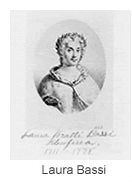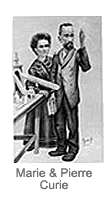Milestones for Women in Science
Celebrating the Achievements of Women
March is Women's History Month. While it is commonplace now for teachers at all levels to integrate materials on women in history, this month provides a welcome opportunity to highlight and celebrate aspects of women's history that are less well known. One of those aspects is women in science.
We begin with a short quiz designed to test your knowledge of milestones for women in science:
- When was the first woman admitted to the prestigious Académie des Sciences in Paris?
- When was the first book published that celebrated women's discoveries in the sciences?
- Has there been a time in history when women developed a science and were the majority of its practitioners?
When was the first woman admitted to the prestigious Académie des Sciences in Paris? Consider first Europe's major scientific academies founded in the seventeenth century: the Royal Society of London in 1660, the Parisian Académie royale des Sciences (perhaps the most prestigious of the academies) in 1666, and the Akademie der Wissenschaften in Berlin in 1700. These academies are today well over three hundred years old. The answer to the question is 1979 (just a few decades ago), when the physicist and mathematician Yvonne Choquet-Bruhat was elected. Significantly, she was the daughter of a prominent mathematician and the wife of an academy member (she was considered, perhaps, a "safe" woman).
When was the first book published that celebrated women's discoveries in the sciences? Extra credit if you know what it was. The answer is 1405, when Book of the City of Ladies was published. In it, Christine de Pizan asked a question still worthy of attention today: have women made original contributions in the arts and sciences? She answered the question positively by emphasizing women's contributions to the invention of writing and calculation and also to practical arts such as the making of bread, the invention of knitting, and the making of fine tapestries.
Has there been a time in history when women developed a science and were the majority of its practitioners? Midwifery offers a prime example of a science developed and practiced by women, most often for the benefit of other women. Since ancient times and at least for two thousand years, women dominated the art of birthing and the field of women's health care. In the eighteenth century, midwifery was taken over by university-trained obstetricians, who were men. By the nineteenth century, midwives were largely banished to the countryside and to the treatment of the poor. It was only in the 1960s and 1970s that the women's movements in Europe and the U.S. were able to begin to reverse these trends and return to women some control over their health care. Today we have seen the triumph of feminism in the biomedical sciences. The National Institutes of Health (NIH) founded its Office of Research on Women's Health (ORWH) in 1990 and implemented the Women's Health Initiative in 1991. Both of these steps are changing health care for women in the U.S.
Women Astronomers, Physicists, and Mathematicians
Universities were closed to women from their founding in the twelfth century until late in the nineteenth century. Why was this so? Were there no qualified women to take their place among the learned?
Historical evidence reveals a small but significant number of women active in science throughout history. The German astronomer Maria Winkelmann is one such woman. As extraordinary as it may seem to us today, she was not an exception: in 1700 when Winkelmann was working, 14 percent of German astronomers were women. (Today only 6 percent are women.) An accomplished astronomer, Winkelmann petitioned the Berlin Academy of Science for an appointment when her husband and Academy astronomer Gottfried Kirch died in 1710. Despite the fact that the great philosopher Gottfried Wilhelm von Leibniz, then president of the Academy, was among her backers, her request was denied. In denying her request, Academy officials set an important negative precedent for women's participation in scientific institutions. The first working woman scientist to become a member of this academy was physicist Lise Meitner (who along with Otto Hahn discovered nuclear fission) in the 1940s, and she was admitted only as a corresponding member.

Another celebrated woman of the eighteenth century was Laura Bassi. In 1732 Bassi became a professor at the University of Bologna, a position she held until her death in 1778. Her field, physics, is one that even today is difficult for women to enter. After a public disputation in Latin (the usual practice at the time), she was awarded her doctorate and appointed by the Pope to her university post. Bassi is also reported (perhaps incorrectly) to have had 12 children, a burden which seems not to have interfered with her scientific productivity—each year she published the results of a new study on electricity, the effects of air pressure, and the like.
Throughout the nineteenth century, women continued their pursuit of science. Notable among them was the Russian-born Sofia Kovalevskaya, famous for her work in partial differential equations.

Women in the 1870s were not allowed to study at Russian universities, and Kovalevskaya resolved to go abroad. Since unmarried women could cross Russia's borders only if accompanied by their father, husband, or other male guardian, Kovalevskaya took the solution of radicals of her day and contracted what was known as a "white" marriage: a marriage of convenience that would allow her freedom of movement. She left Russia to study mathematics at Heidelberg and Berlin. Since the university in Berlin did not grant degrees to women, she traveled to Göttingen, where she finally received her doctorate in 1874. Kovalevskaya went on to win the much-coveted Bordin prize from the Académie des Sciences in Paris in 1888, and in 1889 was appointed professor of mathematics at the University of Stockholm.

The famous twentieth-century physicist Marie Curie was the first person ever—man or woman—to win two Nobel Prizes. Born in Poland, the future Marie Curie traveled to Paris in the 1890s to study mathematics and physics. Here she met and married Pierre Curie. As was the case with so many women in this period, Curie's legitimation in the field came through her husband. He had the professional contacts; she worked initially as his assistant. Their joint work in radiation brought them a Nobel Prize (shared also with Henri Becquerel) in 1903. After her husband's death, Marie Curie not only continued their common work, but also assumed his professorship at the Sorbonne. She was awarded the Nobel Prize again in 1911, this time in inorganic chemistry. Despite the fact that Curie was the first person to win two Nobel Prizes, she did not succeed in her application to the Académie des Sciences in Paris. A spokesman for the Academy held it "eminently wise to respect the immutable tradition against the election of women."
Women in Science Today
The twentieth century witnessed a historic turnaround for women in science. Early in the century, women were admitted to university study nearly everywhere in Europe and the U.S. By midcentury they were receiving Ph.D.s, and by the end of the century women had taken their place as professors. Though numbers differ, countable percentages exist everywhere. Statistics collected between 1996 and 1998 show the Netherlands and Germany tied with the lowest percentage of women as full professors in all fields (5.9 percent each); Austria, Belgium, and Ireland all ranged between 6 and 6.8 percent of women in senior professorships; the United Kingdom stood at 8.5 percent; France had 13.8 percent; and the U.S. had 14 percent. Portugal and Finland enjoyed the highest percentages: 17 and 18.4 percent of women as full professors, respectively.
Today there are many accomplished women in all fields of science. Science practices that for centuries held women at arm's length stand in stark contrast to efforts these days by governments and universities to legislate women into science. Many schools and colleges sponsor special programs to encourage young women in sciences of their choice. The National Science Foundation, the National Institutes of Health, and the European Commission all sponsor programs to encourage and facilitate women's work in the sciences. It is hoped that the intellectual ferment stirred by the entrance of women of all social-economic and ethnic backgrounds into science will open new fields of studies, new questions, and new perspectives on the complex and intricate working of nature.
Further Reading
Schiebinger, Londa. Has Feminism Changed Science? Cambridge: Harvard University Press, 1999.
Schiebinger, Londa. The Mind Has No Sex? Women in the Origins of Modern Science. Cambridge: Harvard University Press, 1989.
Londa Schiebinger is professor of history of science (History Department), and the Barbara D. Finberg Director (the Institute for Research on Women and Gender), at Stanford University. She is author of Plants and Empire: Colonial Bioprospecting in the Atlantic World (Harvard University Press, 2004) and other books in addition to those listed above.
Authored by
Londa Schiebinger
Stanford University
Stanford, California